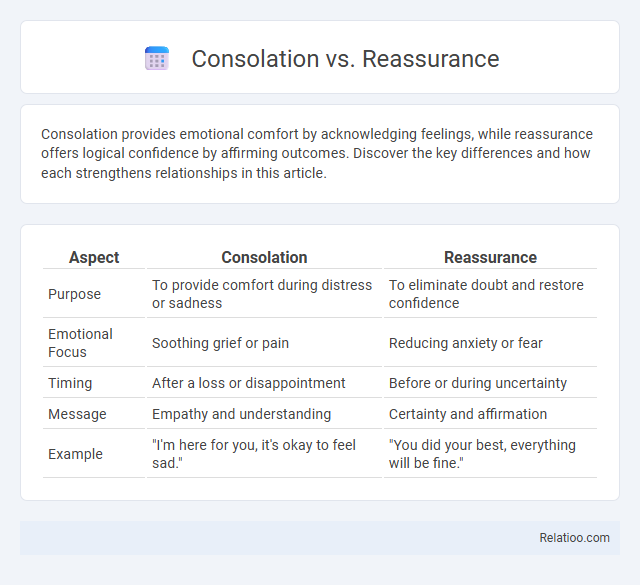Consolation provides emotional comfort by acknowledging feelings, while reassurance offers logical confidence by affirming outcomes. Discover the key differences and how each strengthens relationships in this article.
Table of Comparison
| Aspect | Consolation | Reassurance |
|---|---|---|
| Purpose | To provide comfort during distress or sadness | To eliminate doubt and restore confidence |
| Emotional Focus | Soothing grief or pain | Reducing anxiety or fear |
| Timing | After a loss or disappointment | Before or during uncertainty |
| Message | Empathy and understanding | Certainty and affirmation |
| Example | "I'm here for you, it's okay to feel sad." | "You did your best, everything will be fine." |
Understanding Consolation and Reassurance
Consolation involves offering emotional comfort and support to someone experiencing distress, often acknowledging their feelings without necessarily solving the problem. Reassurance focuses on reducing anxiety by providing affirmations or evidence that alleviates fears and uncertainties, helping individuals regain confidence. Understanding the difference highlights that consolation validates emotions, while reassurance actively dispels doubts and promotes a sense of security.
Defining Consolation: Easing Emotional Pain
Consolation involves providing comfort and empathy to ease emotional pain by acknowledging someone's suffering and offering support that validates their feelings. Unlike reassurance, which aims to reduce doubt or fear through affirmations and promises, consolation centers on sharing sorrow and fostering emotional relief without necessarily solving the underlying problem. Effective consolation strengthens emotional resilience by creating a compassionate connection that helps individuals process grief or distress.
What Is Reassurance? Addressing Uncertainty
Reassurance involves providing comfort and confidence to reduce anxiety or doubt, often by affirming the safety or correctness of a situation. It targets uncertainty by offering factual information or emotional support to help individuals feel more secure. Unlike consolation, which mainly offers sympathy after a loss, reassurance actively addresses worries to restore clarity and calm.
Key Differences Between Consolation and Reassurance
Consolation involves providing comfort by acknowledging someone's pain and offering empathy, whereas reassurance centers on reducing anxiety by affirming a positive outcome or safety. Your approach to consolation focuses on emotional support without necessarily changing the situation, while reassurance seeks to alleviate doubt by reinforcing certainty or confidence. Understanding these distinctions helps you respond effectively to emotional needs depending on whether the goal is to soothe feelings or ease fears.
Psychological Impact of Consolation
Consolation in psychology provides emotional relief by validating feelings of grief or distress, fostering a sense of understanding and connection that can promote healing. Unlike reassurance, which aims to reduce anxiety by offering certainty, consolation accepts the reality of emotional pain, helping individuals process and integrate difficult experiences. Its psychological impact includes enhancing emotional resilience and reducing feelings of isolation through empathetic support.
Psychological Effects of Reassurance
Reassurance offers a psychological buffer that temporarily alleviates anxiety by affirming safety and competence, promoting emotional stability in the face of uncertainty. Unlike consolation, which addresses grief, and support, which involves ongoing assistance, reassurance directly targets cognitive distortions, reducing fear and enhancing confidence. Your ability to provide timely reassurance can significantly influence mental resilience and coping mechanisms during stressful situations.
When to Offer Consolation vs. Reassurance
Offer consolation when someone experiences loss or emotional pain that requires empathy and validation of their feelings, helping them process difficult emotions. Reassurance is more appropriate when a person faces uncertainty or fear and needs affirmation to reduce anxiety and build confidence in a situation. Understanding the context and emotional state ensures the correct approach, with consolation addressing grief and reassurance targeting doubts or insecurities.
Common Misconceptions About Consolation and Reassurance
Common misconceptions about consolation and reassurance often confuse their emotional roles; consolation involves offering empathy and comfort during distress, whereas reassurance focuses on reducing anxiety by affirming safety or outcomes. Many believe both provide the same relief, but consolation validates feelings without necessarily solving problems, while reassurance aims to alleviate fears through certainty. Understanding this distinction enhances effective emotional support in personal and clinical settings.
Role of Empathy in Consolation and Reassurance
Empathy plays a critical role in both consolation and reassurance by fostering genuine emotional connection and understanding, which helps soothe distress and build trust. In consolation, empathy allows caregivers to acknowledge and validate the sufferer's feelings, offering comfort through shared emotional resonance. Reassurance, while also empathetic, emphasizes reducing anxiety by conveying confidence and safety, helping individuals regain stability through informed support.
Applying Consolation and Reassurance in Daily Life
Applying consolation in daily life involves offering empathetic support and acknowledging others' feelings during difficult times, helping to alleviate emotional pain. Reassurance focuses on providing comfort by affirming safety, competence, or positive outcomes, which can reduce anxiety and build confidence. Both consolation and reassurance enhance interpersonal relationships by fostering trust and emotional resilience.

Infographic: Consolation vs Reassurance
 relatioo.com
relatioo.com